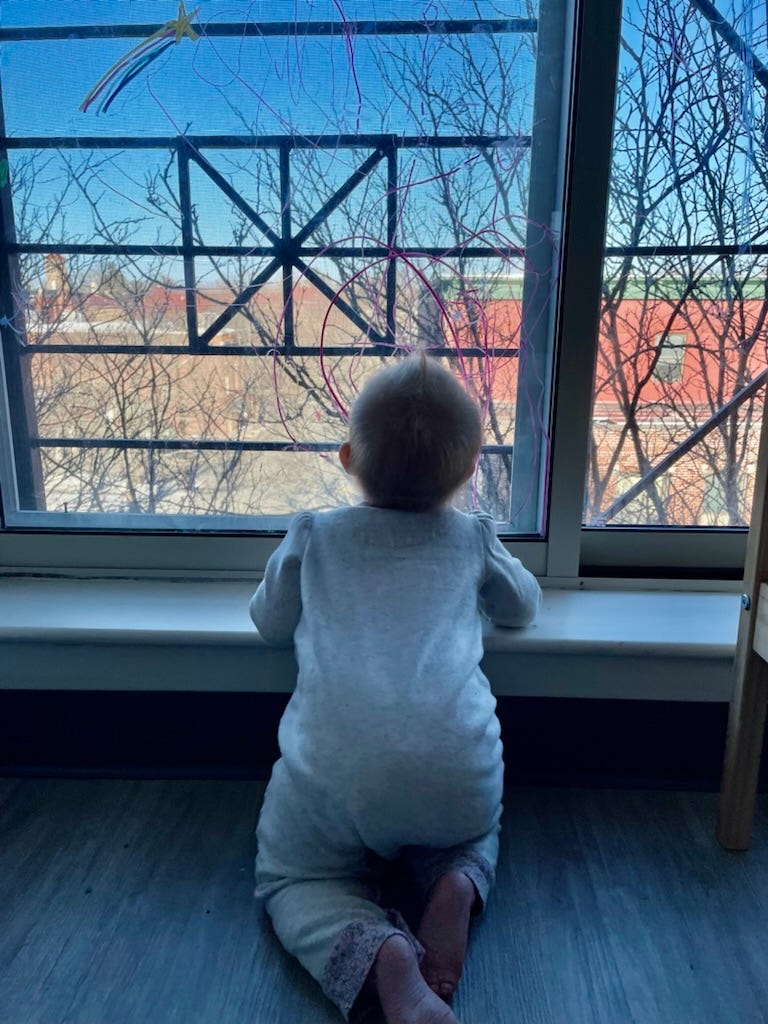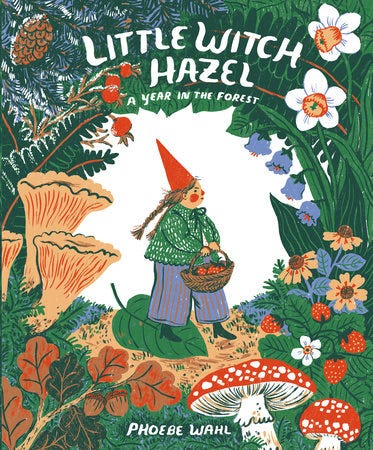Indoorsy
the view from our nest
When we left San Francisco, I pictured us moving into a house with a yard, but for various reasons, we’re on the top floor of an apartment building in downtown Northampton. I call it our birds’ nest because we’re up in the trees and can look over the rooftops to a glimpse of the Holyoke range. We’ve been inside a lot because of Omicron and below-freezing temps and also because we’re homebodies. Eva especially has no desire to leave the house, and I feel guilty for not getting her outside more (“There’s no bad weather, only bad clothing!” chirps the aspirational Scandinavian mom inside me), but maybe embracing the indoors is part of living in a place with real winters.
And then, of course, there’s the never-ending pandemic. I just got a voicemail saying a fellow fifth floor resident has tested positive, further reducing my desire to venture out. We’re all okay. We still have childcare, without which I’d have lost my mind, and you would not be reading this. My heart goes out to any parents without childcare right now.
Our ability to stay home is also dependent on Joe’s job in the emergency department. Everything you’ve heard about hospitals right now is true; they’re completely overwhelmed, and you should do everything in your power to avoid needing one. Joanna had a severe allergic reaction over the holidays, for which we normally would have gone to the ER, but the idea of that scared me worse than her balloon face, so Joe treated her at home. We fortunately already had the epipen on hand for Eva, although we’d gotten lackadaisical about carrying it around since we’ve never had to use it on her. Anyway, moral of the story is that now is not the time to forget the epipen or whatever its equivalent is for you.
Over the holidays, my mom was reading this beautiful book called All Creation Waits, which has a reading for each day of Advent about what a different animal does for the winter. I learned black bears give birth while they hibernate, nursing their cubs as they sleep, waking in the spring to find two or more sets of eager eyes shining back at them. I identify, especially in the early mornings when both kids have ended up in our bed, and I’m dead tired and just like, here, take my body, take whatever you want as long as I can sleep a little longer. Early parenting, in my experience, often feels like a holding pattern, especially in winter when the world outside seems devoid of life. It helps me to remember that there are millions of other nests like ours tucked away in secret spots, with small creatures readying themselves for what come next.
I’m also picking at this book called Wintering by Katherine May when it’s available from our library on the Libby app (my other pandemic lifesaver: I’m usually reading at least half a dozen books with it), which is about spiritual as well as literal winters. Its epigraph is a poem by Edward Thomas called “Thaw”:
Over the land freckled with snow half-thawed
The speculating rooks at their nests cawedAnd saw from elm-tops, delicate as flowers of grass
What we below could not see, Winter pass.
I’m mixing metaphors: birds and bears. But I started a newsletter so I could do things like that. I’m not sure if it’s being up in the trees or having little kids, but I feel more aware than usual of the temporal nature of things. I’ll keep an eye out for signs of winter passing.
I was really touched to have people from all points in my life subscribe to this newsletter; thank you! I wanted to say a little more about its namesake, the movie Another Year. One reason it’s a favorite of mine is because it centers itself around a legitimately happy couple and treats their happiness as a complex subject. (Warning, though, it’s still a very painful watch.) You may have noticed that this isn’t common in art. There’s a wonderful essay by Ursula Le Guin called “All Happy Families” in which she challenges Tolstoy’s famous first line from Anna Karenina (“All happy families are alike; all unhappy families are unhappy in their own way”). She points out that, in reality, family happiness depends upon:
an enormous cost and complexity [. . .], a whole substructure of sacrifices, repressions, suppressions, choices made or forgone, chances taken or lost, balancings of greater or lesser evils—the tears, the migraines, the injustices, the censorships, the quarrels, the lies, the angers, the cruelties it involved—is all that to be swept away, brushed under the carpet by the brisk broom of a silly phrase “a happy family”?
And why? In order to imply that happiness is easy: shallow, ordinary; a common thing: not worth writing a novel about? Whereas unhappiness is complex, deep, difficult to attain, unusual; unique indeed: and so a worthy subject for a great, a unique novelist? Surely that is a silly idea. But silly or not, it has been imposingly influential among novelists and critics for decades.
In fiction I’m working on now, I’m writing about both murder and suicide, so maybe I’ve internalized the idea that unhappiness is the only worthy subject for art. But in my life and here, I want something else.
The other thing I love about Another Year is that it’s structured around one year, with four seasonal parts. I find that kind of temporal unity very satisfying. I’ll sign off with recommendations for a couple kids’ books I love that are also structured around the seasons of a year:
Little Witch Hazel by Phoebe Wahl - I’m guessing this was one of those surprise bestsellers that wasn’t restocked because of supply chain issues, since it was sold out everywhere for the past several months. But after a long wait, we were finally able to get a copy from our library, and it's a delight. I’m a huge fan of Phoebe Wahl’s exquisite illustrations; Eva loves the owl-related storyline; and Joe identifies with Little Witch Hazel, particularly her difficulty letting go and relaxing in the “Summer” chapter.
The Year at Maple Hill Farm by Alice and Martin Provensen- I’m obsessed with this book and its companion, Our Animal Friends At Maple Hill Farm, both of which describe the animals and seasons on a farm in funny, honest ways. The animals are individuals rather than broad categories, and their annoying habits are given just as much love and attention as their assets. Our Animal Friends also acknowledges that animals die, but in a way that's gentle enough for Eva to absorb.
If you have any favorite art, for kids or adults, that’s structured around a year, I’d love to hear about it!




I love reading about your life 💜💜